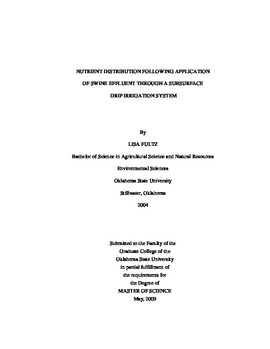| dc.contributor.advisor | Hattey, Jeffory | |
| dc.contributor.author | Fultz, Lisa | |
| dc.date.accessioned | 2014-04-15T22:06:04Z | |
| dc.date.available | 2014-04-15T22:06:04Z | |
| dc.date.issued | 2009-05-01 | |
| dc.identifier.uri | https://hdl.handle.net/11244/9327 | |
| dc.description.abstract | Concerns' regarding utilization of animal waste in agriculture have led to the use of systems such as subsurface irrigation to minimize contact between above ground biomass and the waste. However little is known about the movement and distribution of nutrients applied via subsurface irrigation systems. The purpose of this study is to determine the distribution of nutrients found in swine effluent when applied through a subsurface drip irrigation system located on the Panhandle Research Station in Goodwell, Oklahoma. Suction lysimeters were used to collect solution samples at and between emitters on the inlet and distal ends of a single irrigation tape. Solution samples were obtained from fields with application rates of 2.38 L h-1 (0.63 gph) and 0.72 L h-1 (0.19 gph) respectively. Soil solution samples taken prior to swine effluent application were used to determine background levels of measured nutrients from previous effluent applications. Solution samples drawn within one day following each effluent application were used to determine the distribution and movement of nutrients. pH values, electric conductivity, orthophosphates, nitrate-N, ammonia-N, copper, zinc, and calcium was preformed on each sample. Calcium and copper concentrations increased over time regardless of application rate. Increased application rates (2.38 L h-1) resulted in increased NO3--N laterally with regards to the irrigation tape. Orthophosphate concentrations decreased with depth indicating no downward movement regardless of application rate. Emitter application rates of 0.72 L h-1 resulted in no significant correlation between lysimeter location and nutrient concentration, with the exception of orthophosphate. Based on the results of this study it appears that nutrients are not being lost. At the 2.38 L h-1 emitter application rates NO3--N and OP concentrations near the surface place these nutrients directly in the rooting zone for the plants. | |
| dc.format | application/pdf | |
| dc.language | en_US | |
| dc.publisher | Oklahoma State University | |
| dc.rights | Copyright is held by the author who has granted the Oklahoma State University Library the non-exclusive right to share this material in its institutional repository. Contact Digital Library Services at lib-dls@okstate.edu or 405-744-9161 for the permission policy on the use, reproduction or distribution of this material. | |
| dc.title | Nutrient Distribution Following Application of Swine Effluent Through a Subsurface Drip Irrigation System | |
| dc.type | text | |
| dc.contributor.committeeMember | Deng, Shiping | |
| dc.contributor.committeeMember | Kizer, Michael | |
| osu.filename | Fultz_okstate_0664M_10328.pdf | |
| osu.college | Agricultural Sciences and Natural Resources | |
| osu.accesstype | Open Access | |
| dc.description.department | Department of Plant and Soil Sciences | |
| dc.type.genre | Thesis | |
